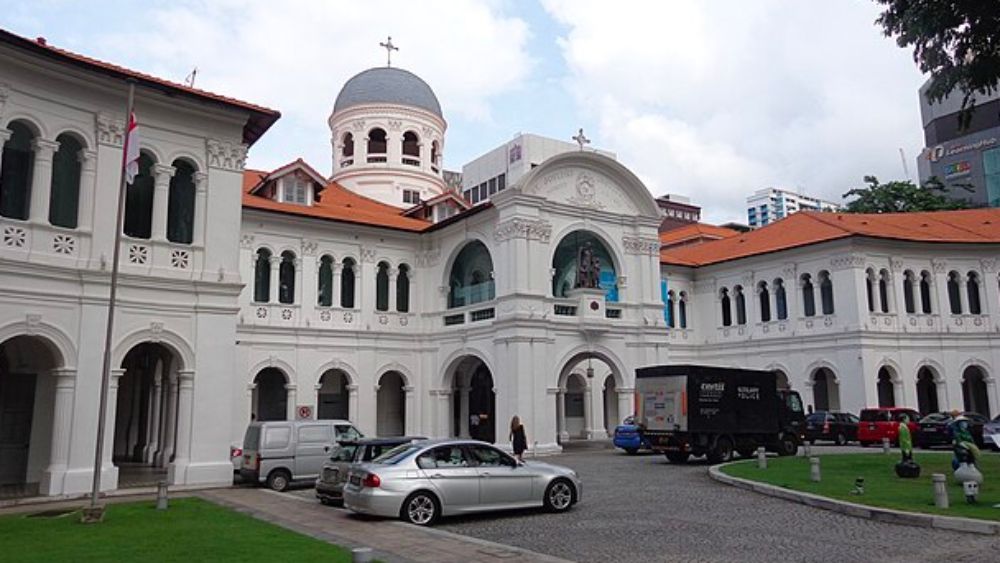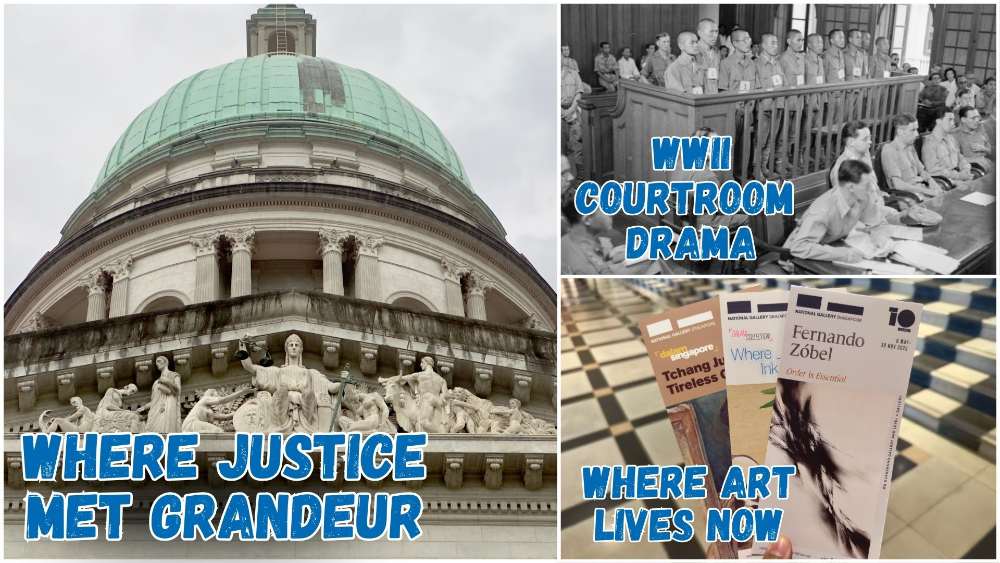How Singapore’s First Catholic Boys School Became A War Hospital, Then An Avant-Garde Art Haven
What is a National Monument? Who gazettes them? How many national monuments are there in Singapore? To date, the Preservation of Sites and Monuments, a division of National Heritage Board, has identified and gazetted 75 buildings, structures and sites of national significance as an integral part of Singapore’s built heritage.
And we're here to tell you all about them - one National Monument at a time!
You've probably passed by or stepped into more than a few of them without realising they were National Monuments: Al-Abrar Mosque, Asian Civilisations Museum, the Civilian War Memorial, Saint Andrew's Cathedral, the Esplanade Park Memorials, Fort Siloso on Sentosa - no need to plan an itinerary for friends visiting from overseas; just show them this article ✌️
In this edition, we spotlight the oldest Catholic boys' school in Singapore, the former Saint Joseph's Institution (now Singapore Art Museum).
📍 Location
The former Saint Joseph's Institution (SJI) was the 31st building to be gazetted as a National Monument, and is located near other National Monuments such as Church of Saints Peter and Paul, Maghain Aboth and Cathedral of the Good Shepherd. The MRT station nearest to the former SJI is Bencoolen.
📅 Significant dates
Dates built:
- 1 May 1852: Saint Joseph's Institution (SJI) was founded in a small chapel made of wood and attap, along Bras Basah Road
- 1855-1867: The former SJI was constructed
- 1988: SJI moved to its current campus at Malcolm Road
- 1992-1996: Singapore Art Museum (SAM) was built on the grounds of the former SJI
Milestones:
- 19 Mar 1855: The foundation stone for the former SJI building was laid
- 1903-1906: Two semi-circular wings, one on each side of the original building, were added
- 3 Aug 1907: Anderson Building was built
- 1911-23 Sep 1912: King George's Hall and Chapel was completed
- 1913: A statue of Saint Jean-Baptiste de La Salle was installed
- 20 Jan 1996: SAM opened its doors to the public
Date gazetted: 14 Feb 1992
📜 History
In 1851, Reverend Father Jean-Marie Beurel, MEP (short for "Société des Missions Etrangères de Paris" or "Society of Foreign Missions of Paris", a Catholic missionary organisation), was instructed by the then-Vicar of Malaya Bishop Jean-Baptiste Boucho, MEP, to recruit teachers for the mission in Singapore.
He set off for France, where he successfully sought help from two teaching congregations: the Institute of the Brothers of the Christian Schools, and the Congregation of the Sisters of the Holy Infant Jesus (CHIJ, or the Dames of Saint Maur).
The CHIJ Sisters later founded the Convent of the Holy Infant Jesus on Victoria Street. Three de La Salle Brothers (as the Christian Brothers were also called, after the founder of their congregation Saint Jean-Baptiste de La Salle) started a free school, Saint John's Institution, in a small former chapel made of wood and attap on Bras Basah Road on 1 May 1852.
While the school was intended mainly for the education of Catholic children, it also welcomed other children irrespective of religion, race, and social class. Brother Lothaire, one of the brothers accompanying Father Beurel on his return journey from Paris in 1852, designed a new building for the school.
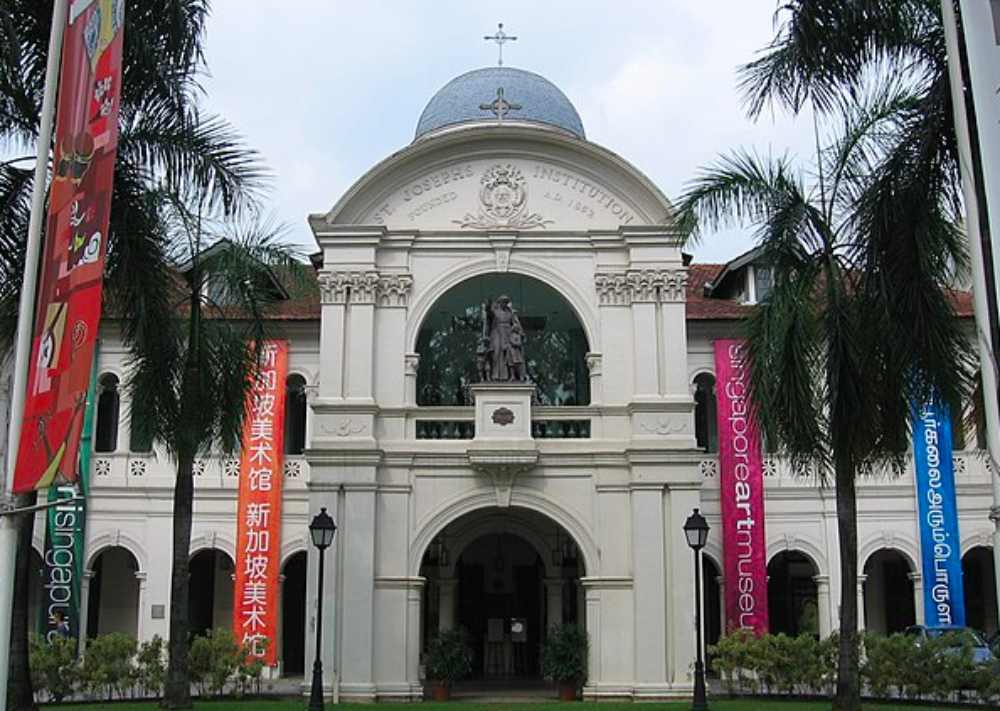 IMAGE: WIKIMEDIA COMMONS/@SENGKANG
IMAGE: WIKIMEDIA COMMONS/@SENGKANG
The cornerstone was laid on 19 Mar 1855, the feast day of Saint Joseph. Consequently, the name of the school was changed to Saint Joseph's Institution (SJI) to commemorate this significant milestone and auspicious event. The two-storey rectangular structure was completed only in Aug 1867, topped with a pitched roof and a small belfry in the middle.
At the time of the Second World War, SJI was taken over as a hospital for military casualties shortly before the Japanese invasion. During the Japanese Occupation (1942–1945), the school was renamed Bras Basah Boys' School. More than 10 brothers were taken prisoners and were interned at Changi Prison. In the meantime, Japanese was taught in the school. Gardening also became part of the curriculum as food was scarce; the brothers and students grew vegetables within the school compound.
By the 1980s, the compound of the former SJI was too small and congested to accommodate the large number of students. The facilities of the 130-year-old school were getting outdated, and the noise from the traffic on Bras Basah Road proved to be a distraction during lessons. In 1988, SJI departed from its old campus, and moved to its current location on Malcolm Road.
Works commenced on the former school building four years later under the guidance of the Public Works Department to prepare it for its present occupant, the Singapore Art Museum (SAM). The contemporary art museum opened its doors to the public on 20 Jan 1996.
Since 2019, SAM has been undergoing renovation works; the museum is temporarily located at Tanjong Distripark.
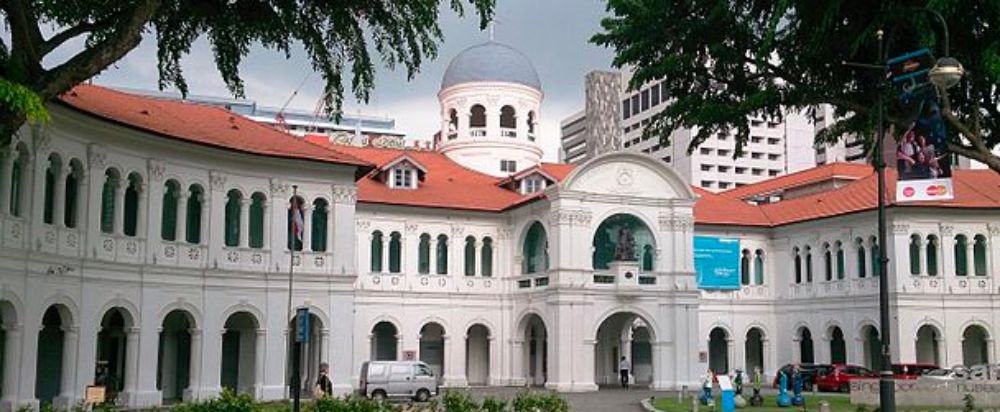 IMAGE: WIKIMEDIA COMMONS/@PROJECTMANHATTAN.
IMAGE: WIKIMEDIA COMMONS/@PROJECTMANHATTAN.
📐 Design and architecture
Over the years, the former SJI building saw a number of additions to the original compound.
By the start of the twentieth century, SJI had already established itself as one of the most prestigious schools in Singapore. Enrolment increased rapidly and more brothers were recruited. Classrooms were overcrowded, and there was an urgent need for expansion.
The task of expanding the school fell on the new Irish-American director, Brother Michael Noctor, who assumed the position in 1900. After consulting architectural firm Swan & Maclaren, Brother Michael abandoned the plan to add a third storey onto the existing building.
Instead, he approached Father Charles B. Nain (an amateur architect and the then-assistant parish priest at the nearby Church of Saints Peter and Paul) for help. The talented priest was also responsible for the design of the Former Convent of the Holy Infant Jesus and the Church of the Nativity of the Blessed Virgin Mary.
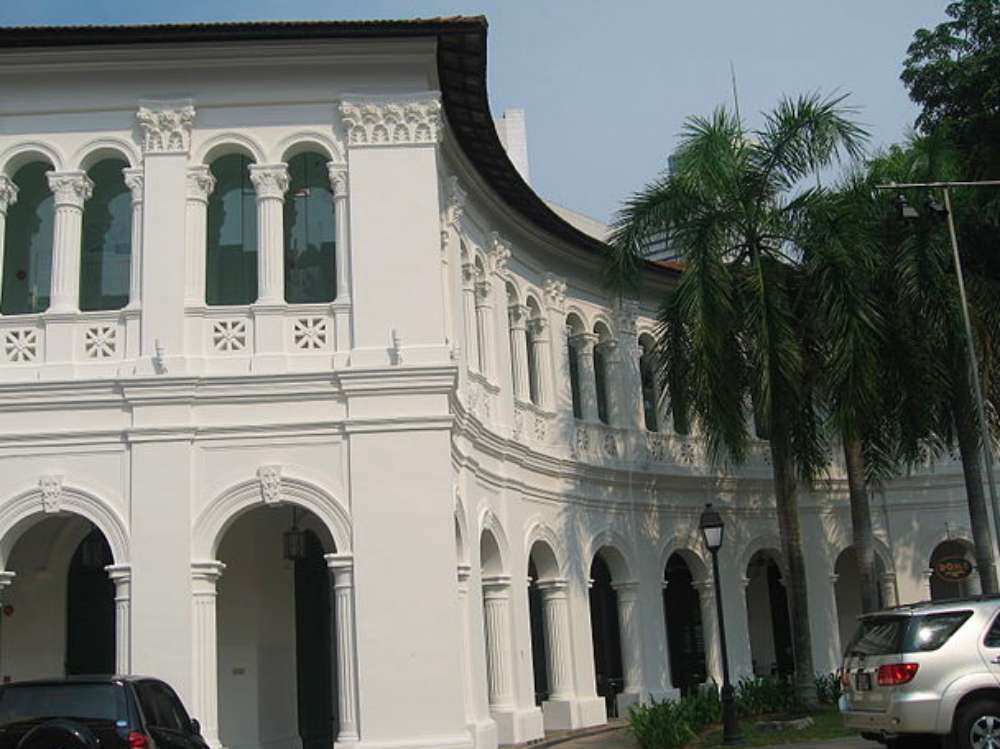 IMAGE: WIKIMEDIA COMMONS/@TERENCE ONG
IMAGE: WIKIMEDIA COMMONS/@TERENCE ONG
Father Nain designed two semi-circular wings, one on each side of the old block. The spacious verandahs of the new extensions are lined with arched openings. By enlarging the verandah on the front of the original structure, a porte-cochere (carriage porch) was created. A pediment (upper part of the front of a building) bearing the name of the school and its crest was also added to the old block in the middle, and was repeated at both ends of the newly built wings. The original belfry was replaced by a larger dome, which was more proportional to the enlarged facade.
In 1906, Brother Michael embarked on yet another building project to cope with the ever-increasing enrolment. Donations streamed in from the European and Chinese communities. Among the donors were Tan Jiak Kim (陈若锦), a prominent Straits Chinese merchant who was instrumental in the founding of Singapore’s first medical college in 1905, and then-Governor of the Straits Settlements Sir John Anderson. This time, Brother Michael engaged the engineer Robert Hamilton to design the new wing.
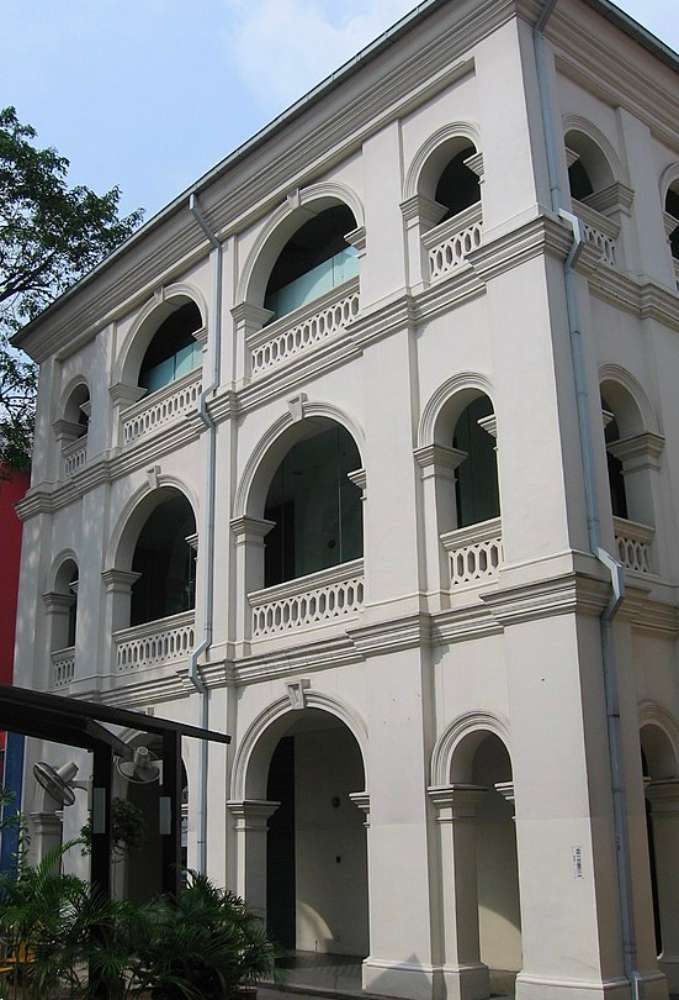
IMAGE: WIKIMEDIA COMMONS/SENGKANG
The completed three-storey rectangular block was ceremoniously opened on 3 Aug 1907 by Governor John Anderson, in whose honour the new building was named. Anderson Building echoes the architectural features of the school’s curved extensions. However, the simpler Doric columns and pilasters give the block a more modern appearance.
In 1911, Brother Michael began the construction of a school hall and a chapel. The two were built according to the plans made by the architect C. Hunsley in less than a year. On 23 Sept 1912, Governor of the Straits Settlements Arthur H. Young officiated at the opening of the new hall, King George's Hall. At the time of its completion, it was one of the largest school halls in Singapore. The hall was designed as an open loggia (a roofed open gallery), which allowed the interior space to be naturally illuminated and ventilated.
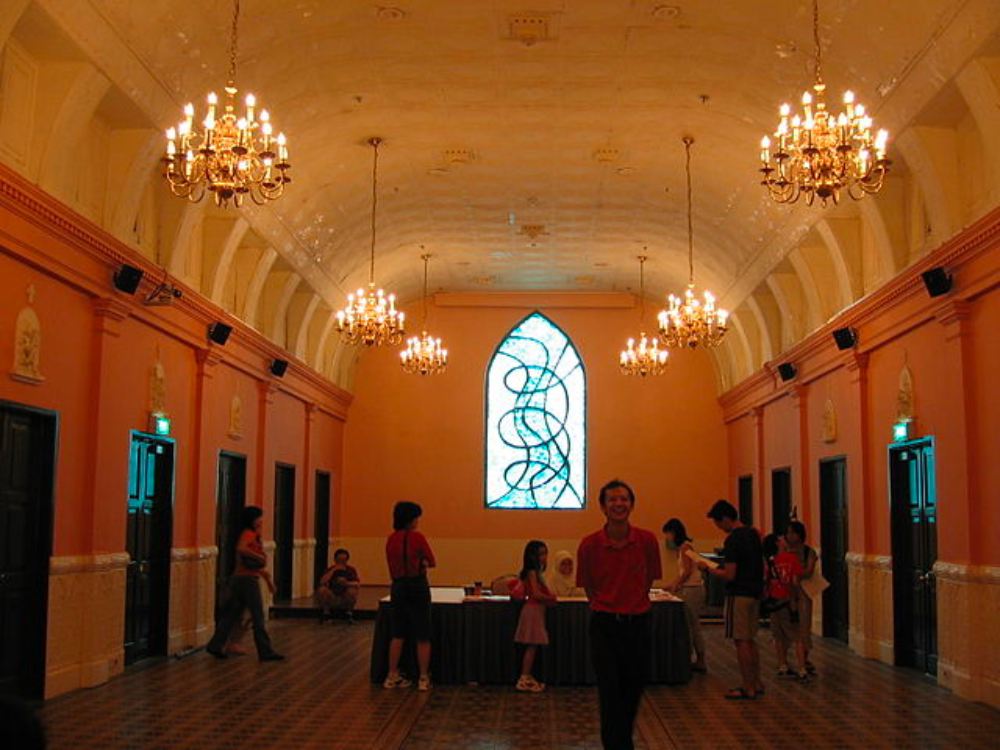 IMAGE: WIKIMEDIA COMMONS/@SENGKANG
IMAGE: WIKIMEDIA COMMONS/@SENGKANG
Due to the late arrival of the stained-glass window from Europe, the chapel’s dedication was delayed until 20 Nov 1912, with the first Holy Mass celebrated the following day. The stained-glass window was removed during the Second World War for safekeeping; the pieces were unfortunately never recovered. Circular patterns decorate the ceiling, while the floor is covered with brightly coloured tiles.
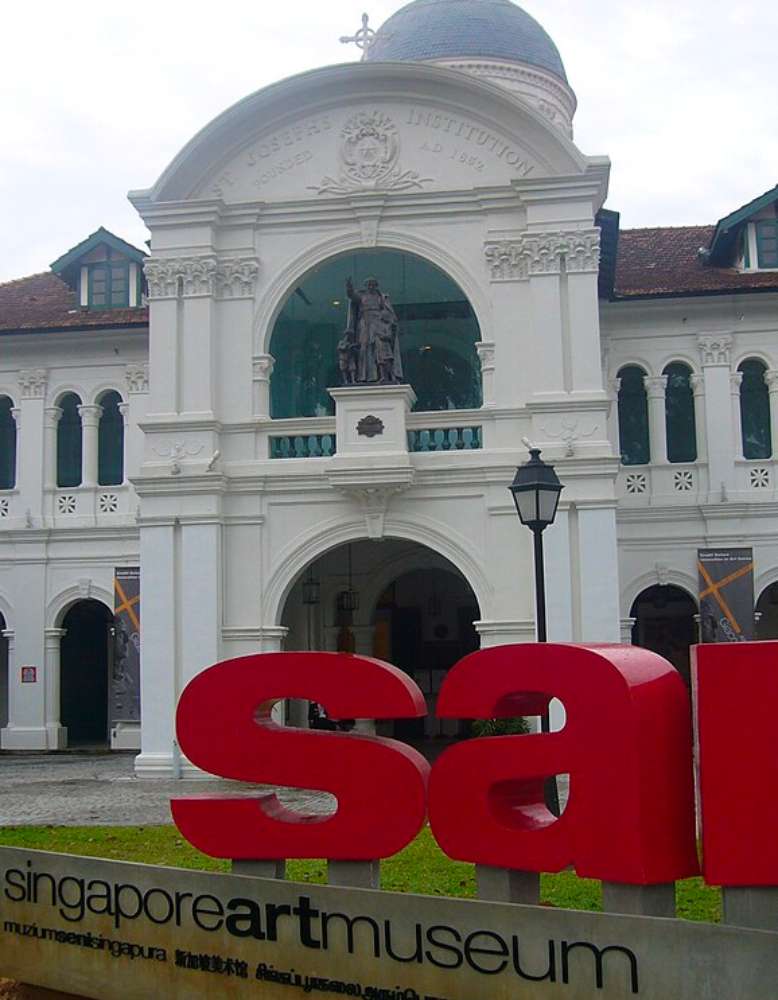
IMAGE: WIKIMEDIA COMMONS/@JORDIFERRER
A year after the school's 60th anniversary in 1913, the iconic bronze statue of two children with Saint Jean-Baptiste de La Salle pointing afar was cast and placed just above the main entrance. It was donated by a certain Mr La Salle, a resident of Singapore. The lifelike statue was crafted by the well-known Italian artist Cesare Aureli; it is a half-sized replica of the original statue standing in the central nave of Saint Peter’s Basilica in the Vatican City, also made by the same sculptor.
🕖 Opening hours
The former Saint Joseph's Institution (now SAM) has been closed since 2019 for renovations.
SAM is currently housed at Tanjong Pagar Distripark, and is open daily from 10am to 7pm (last entry at 6.30pm).
🎟️ Admission
Entry is free for Singaporeans and Permanent Residents. Find out more here.
For the latest updates on Wonderwall.sg, be sure to follow us on TikTok, Telegram, Instagram, and Facebook. If you have a story idea for us, email us at [email protected].







